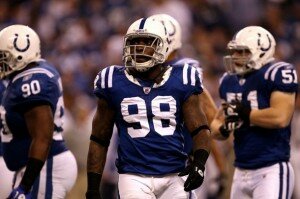Looking Forward at the 2011 Colts Defensive Ends

Robert Mathis looks on against the New York Jets during the 2011 AFC wild card playoff game. (Jonathan Daniel | Getty Images)
Dwight Freeney and Robert Mathis continued to be the NFL’s most dominant defensive end tandem in 2010. Their propensity for pressuring, hitting, sacking, and stripping the quarterback of the football will go down in league history as one of the most intimidating pass rushing units out of the 4-3 defense.
Many hoped that 2010 first round pick Jerry Hughes would immediately step in to bolster Indy’s pass rush, including Colts President Bill Polian, but Hughes did not become a meaningful part of the defense as a rookie. What his future holds is uncertain. While some might believe that Polian’s admission that he should have selected offensive tackle Rodger Saffold in the draft is an indictment of Hughes, coaches and members of the front office have all suggested that slow learning curves are not uncommon for defensive ends transitioning to the NFL.
In some way, such consternation over a slowly developing defensive lineman seems odd given that 2009 second round pick Fili Moala was a disappointment as a rookie who started all year in his second season — and played well enough to justify his promotion. Delaying reservations and evaluations with Hughes is probably the best approach.
Possibly the biggest surprise at end this season was that Keyunta Dawson, who typically has been ineffective in both run defense and pass rushing, showed a few spurts of starting to get it. The problem for Dawson is that there are too many other players around who are more talented and would make more sense for the franchise. While Indianapolis has been loyal to Dawson to this point, do not be surprised to see practice squad standout John Chick, second-year hybrid defensive tackle Ricardo Mathews, or a draft pick/free agent take his place in 2011.
Speaking of Chick — the 2009 Canadian Football League’s Most Outstanding Defensive Player spent the entire season on the practice squad. Such long stays are uncommon, even during normal seasons. Maintaining that spot even when the franchise was scrambling to fill roster spots at other positions affected by injury indicates that the Colts did not want to give up on their investment in Chick. He is a high energy – high character player who will work as hard as anyone for his chance in 2011. After a full season to learn the defense and catch up with the likes of players like Dawson, there is a good chance Chick can win that competition.
One high profile free agent will hit the market this off-season that will rightfully give fans in Indianapolis cause to salivate — New York Giants defensive end Mathias Kiwanuka. Consider that Kiwanuka is an Indianapolis native, attended Cathedral high shcool, has played both as a strong-side linebacker and defensive end for New York, and that his development and sack numbers were limited by playing on a team that also featured Michael Strahan, Osi Umenyiora, Justin Tuck, and rookie Jason Pierre-Paul throughout his career. Kiwanuka is two years younger that Robert Mathis, would not demand a contract as large as Mathis, and could guarantee Indy that it has a stocked rotation of pass rushers for the remainder of Peyton Manning’s career. It would also reduce the pressure on Hughes to rush his development.
It should be understood that if a move as big as acquiring Kiwanuka does occur, it will all but spell the end for Mathis’ career in Indianapolis. Letting Robert go would not be a popular move, but in the dog-eat-dog world of developing and maintaining a competitive roster under a salary cap (there most certainly will be a cap once the new CBA is negotiated), difficult and unpopular decisions are part of the territory.
If the Colts front office is able to retain hybrid defensive tackle Eric Foster, is satisfied with the development of Ricardo Mathews, is confident in Hughes’ and Chick’s development, and plans to re-sign Mathis to what will probably be the last contract of his career, the team is set for 2011. If not, Kiwanuka will at least spark a real discussion amongst fans and coaches in Indianapolis. Regardless of the decision, keep in mind that drafting cornerbacks, safeties, and defensive ends is one of Bill Polian’s favorite things to do. He loves finding great value at the position in the late rounds and he will not be shy to make the competition for spots on the roster even tighter as the team prepares for the summer.
| Print article | This entry was posted by Brett Mock on February 2, 2011 at 6:30 am, and is filed under Off-Season Coverage. Follow any responses to this post through . You can skip to the end and leave a response. Pinging is currently not allowed. |

Click here to try reconnecting the live stream.
